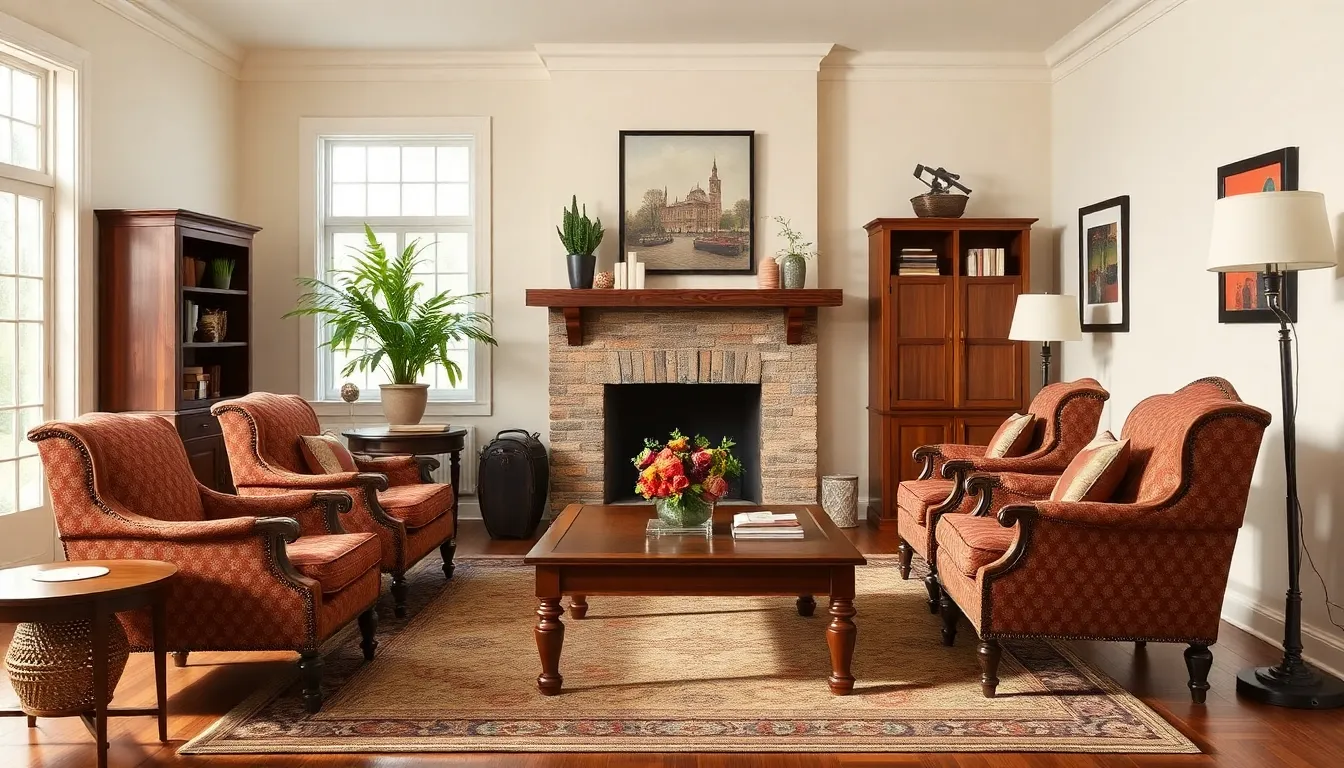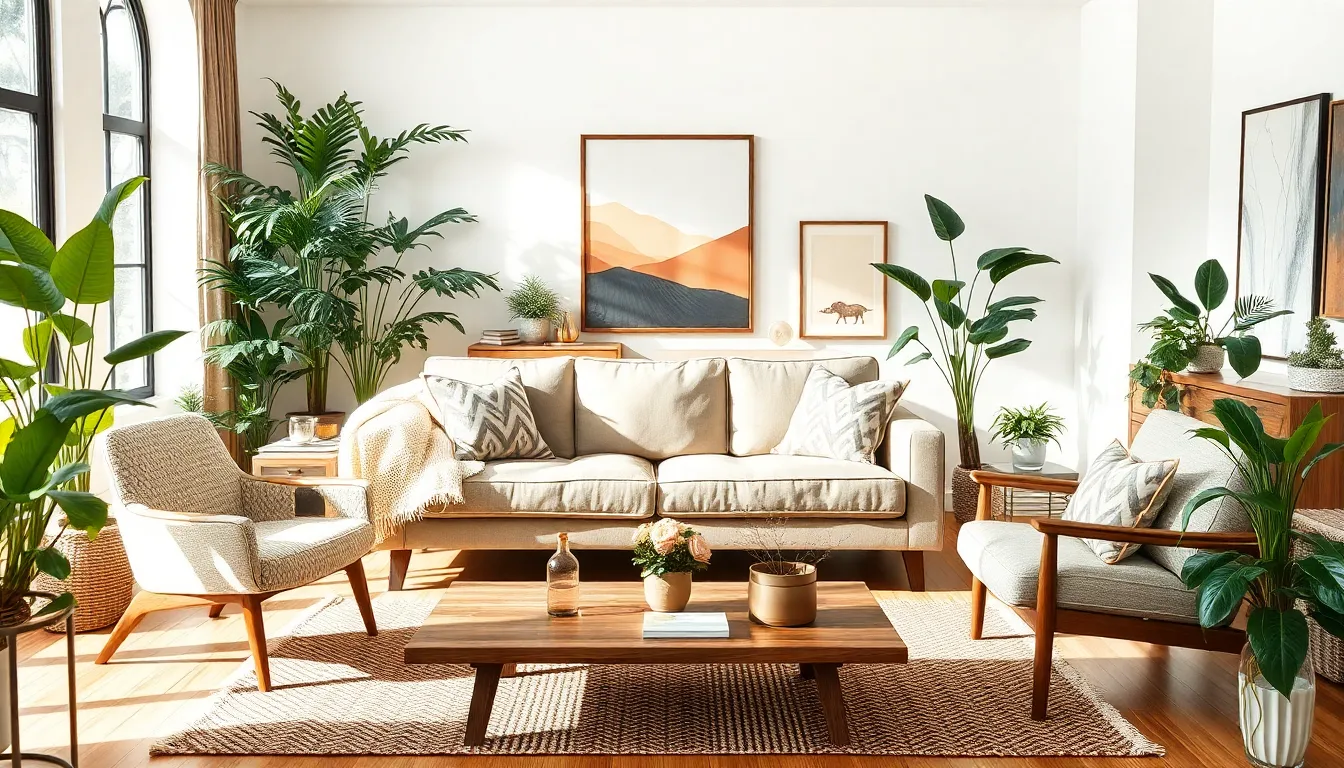When it comes to furniture, style isn’t just a preference; it’s a personality statement. Whether you’re channeling your inner minimalist or embracing the cozy chaos of bohemian vibes, the right furniture can transform a house into a home. Imagine walking into a space that feels like you—where every piece tells a story and every corner invites you to kick back and relax.
From sleek mid-century modern to rustic farmhouse charm, furniture styles can be as diverse as the people who choose them. It’s like picking an outfit for your living room; you wouldn’t wear sweatpants to a gala, so why let your decor be a fashion faux pas? Dive into the world of furniture styles and discover how to dress your space in a way that reflects your unique taste and makes your guests wonder if you’ve secretly hired an interior designer.
Table of Contents
ToggleOverview of Furniture Styles
Furniture styles encompass a wide range of designs, each with distinctive characteristics and influences. Modern pieces feature clean lines and minimal ornamentation, appealing to those who favor simplicity. In contrast, traditional styles display rich textures and intricate details that evoke warmth and comfort.
Mid-century modern design reflects the aesthetics of the 1950s and 1960s, incorporating organic forms and functional design elements. Rustic farmhouse furniture prioritizes natural materials, creating a cozy and inviting atmosphere. Industrial style showcases raw materials like metal and wood, emphasizing a utilitarian approach.
Contemporary furniture leans toward innovation and current trends, often blending styles to create unique looks. Scandinavian design emphasizes functionality and minimalism, while adding a touch of warmth with light woods and soft textiles. Vintage pieces infuse nostalgia, offering timeless charm and character to any space.
Eclectic styles allow for mixing various elements, encouraging personal expression and creativity. Coastal design draws inspiration from beach aesthetics, utilizing light colors and airy fabrics to evoke a relaxed vibe. Art Deco channels glamour through bold patterns and luxurious materials, appealing to those who enjoy opulence.
When choosing a furniture style, consideration of individual preferences and needs plays an essential role. Combining elements from different styles can create a truly personalized space. Exploring these furniture styles not only enhances living environments but also showcases unique identity and taste.
Traditional Furniture Styles

Traditional furniture styles emphasize timeless elegance and craftsmanship. These styles often reflect cultural influences, showcasing intricate details that enhance the beauty of any space.
Characteristics of Traditional Styles
Traditional styles exhibit rich materials and craftsmanship. Intricate carvings often adorn wood surfaces. Rich colors contribute to a warm, inviting atmosphere. Ornate fabrics provide texture and depth. Functional yet decorative elements create balance in design.
Popular Traditional Styles
Some popular traditional styles include Colonial, Victorian, and Shaker. Colonial furniture features simple lines and symmetry. Victorian styles display flamboyant details and opulent materials. Shaker pieces prioritize functionality with minimalist designs. Each style tells a unique story and enhances any living environment with its distinct character.
Modern Furniture Styles
Modern furniture styles focus on simplicity and functionality. These pieces blend aesthetics with practicality, creating inviting spaces that reflect contemporary tastes.
Features of Modern Designs
Clean lines define modern designs. Minimal ornamentation emphasizes form over decoration. Neutral color palettes enhance the sleek look, while materials like metal, glass, and wood provide durability and style. Solid surfaces create an unobtrusive backdrop for layered textures, fostering a serene environment. Functionality remains paramount, with multipurpose furniture becoming increasingly popular. In addition, innovation drives modern designs, encouraging sustainable practices and cutting-edge technology in production.
Notable Modern Styles
Mid-century modern stands out for its iconic shapes and vibrant colors. Minimalism emphasizes a clutter-free lifestyle with essential furniture pieces. Scandinavian design incorporates natural materials and promotes warmth, balancing functionality and aesthetics. Industrial style attracts those who appreciate raw and unfinished elements. Contemporary furniture often blends various influences, creating unique combinations that cater to individual preferences. Each modern style offers distinctive features while adapting to changing tastes.
Rustic and Cottage Furniture Styles
Rustic and cottage furniture styles celebrate warmth and simplicity, creating inviting living spaces. These styles focus on natural materials and handcrafted elements, reflecting a connection to nature.
Key Elements of Rustic Design
Rustic design highlights raw materials like wood and stone, creating a grounded feel. Handcrafted furniture pieces often feature visible joinery and imperfections that enhance their character. Earthy color palettes, such as browns, greens, and warm neutrals, dominate these spaces. Textures play a crucial role, with soft fabrics and woven elements providing comfort. Antiques and vintage finds add charm and history, bridging the past with the present. Functionality drives rustic furnishings, promoting practicality without sacrificing style. These characteristics make rustic design both timeless and appealing, offering comfort in any home.
Cottage Style Overview
Cottage style embraces a cozy, lived-in aesthetic, often reflecting a carefree lifestyle. Light colors, such as pastels and whites, create an airy ambiance, while floral patterns add a touch of whimsy. Furniture items typically combine painted finishes with natural wood, enhancing character. Comfort remains paramount, with overstuffed sofas and plush chairs inviting relaxation. Open shelving showcases personal collections, enhancing the informal vibe. Accessorizing with handmade or vintage items contributes to the overall charm, making each space feel unique. This style embodies a cheerful atmosphere, transforming any area into a welcoming retreat.
Contemporary Furniture Styles
Contemporary furniture styles reflect the dynamic nature of today’s design landscape, merging aesthetics with functionality. These styles embody current trends while remaining adaptable to personal preferences.
Defining Contemporary Characteristics
Contemporary furniture features clean lines and smooth surfaces that convey simplicity. Bold colors and geometric shapes also dominate this style, emphasizing a minimalist approach. Natural materials, such as wood and metal, play a prominent role, providing an organic touch to spaces. Open spaces and multifunctional furniture pieces enhance practicality, catering to modern lifestyles. The overall aesthetic creates a fluid environment that feels both inviting and sophisticated.
Trends in Contemporary Furniture
Trends in contemporary furniture constantly evolve, embracing innovative designs and materials. Sustainable practices have gained prominence, with eco-friendly materials being integral to many new collections. In addition, technology integration has become essential, with smart furniture offering convenience and functionality. Statement pieces that evoke individuality and personalization become focal points in modern interiors. Fashion-forward colors, such as jewel tones, and unexpected textures enhance the overall visual appeal. As a result, designers prioritize versatility, ensuring that contemporary styles cater to diverse tastes and preferences.
Exploring furniture styles opens a world of possibilities for creating a space that truly reflects one’s personality. Each style offers unique characteristics that can transform a house into a home. By mixing and matching elements from various styles, individuals can curate an environment that not only meets their aesthetic preferences but also enhances comfort and functionality.
Whether drawn to the elegance of traditional pieces or the sleek lines of contemporary designs, the key is to choose what resonates personally. Embracing diverse styles encourages creativity and allows for a living space that tells a story, making every room a true expression of identity.




